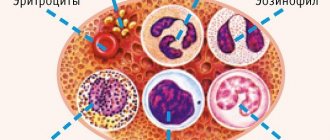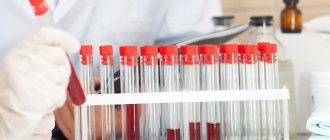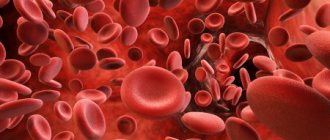Pregnancy, children > Pregnancy > Examinations > Preparation for 1st trimester screening and analysis of its results
Pregnancy is always considered the main event in the life of every person. Especially for women. As soon as the second line appears on the test to determine pregnancy, it is already known that life will change and everyone is looking forward to the first ultrasound examination. If, of course, you are interested in looking at the future baby, then you can contact any paid clinic. In addition to the fact that they will give you the results of the ultrasound, they will also give you a photo of the baby.
Women who are 35 years of age or older undergo all necessary examinations in more specialized clinics. For example, if in the city of Nizhny Tagil they are sent to the perinatal center of the city of Nizhny Tagil for screening in the 1st trimester, then women over the age of 35 are sent to the city of Yekaterinburg. And several more examinations are carried out.
The first ultrasound is performed in early pregnancy, this period reaches 11-13 weeks, that is, this is the third month of pregnancy. In the medical field, such an ultrasound is usually called screening.
First trimester screening
As already written above, it is carried out no earlier than the eleventh, but no later than the thirteenth week.
It is during this period that the so-called embryonic period of fetal development ends, and the fetal period begins. This means that the embryo turns into a fetus, and organs begin to develop, like those of a full-fledged human being. During this period, pathologies or abnormalities can be identified.
Of course, only a specialist will correctly interpret the screening results, but expectant mothers can at least learn in general terms what to expect and what some indicators may mean.
You can refuse screening, but doctors do not advise it
All pregnant women are referred, but this procedure can be refused. Doctors do not recommend refusing, as this is a negligent attitude towards the baby’s life. The following groups of women should also be examined:
- over 35 years old;
- there were unsuccessful attempts to give birth - a frozen fetus, a miscarriage;
- those who work in production and may come into contact with harmful substances;
- who gave birth to a child with disabilities in the past;
- during the first weeks, those who had an infection;
- taking medications prohibited for the first trimester;
- those suffering from alcoholism or drug addiction;
- when there is a threat of miscarriage;
- if there are pathologies in the family.
There is a special medical worker - a sonologist, who carries out the procedure. At this time, there are two options - abdominal and transvaginal examination. They prefer the second one, as it is more reliable.
There are machines for home ultrasound
The woman is asked to undress to the waist and lie on the couch with her legs bent. Then a thin sensor in a condom is inserted into the vagina. It will be moved to fully examine the fetus, this may cause discomfort, but not pain. After the procedure, some discharge may appear on the underwear, perhaps a little bloody.
This is normal, no need to worry. Ultrasound of the abdominal area does not give reliable results at this stage, but if it is chosen, the woman is asked to lift her clothes to expose her stomach. Then you will have to wait for the results - in public hospitals for up to five days. After this, you need to donate blood for analysis.
It is known that not even all government agencies are ready to provide such a service free of charge. Blood biochemistry alone exceeds one and a half thousand rubles, and you also have to pay for the ultrasound procedure itself. Each clinic sets the cost differently, but it is unlikely to be less than two thousand rubles.
According to Order No. 457 of the Ministry of Health of the Russian Federation of 2000, prenatal screening is recommended for all women. A woman can refuse it, no one will force her to do this research, but doing this is extremely reckless and only speaks of the woman’s illiteracy and negligent attitude towards herself and, above all, towards her child.
Risk groups for whom prenatal screening should be mandatory:
- Women whose age is 35 years or more.
- The presence of a threat of termination of pregnancy in the early stages.
- History of spontaneous miscarriage(s).
- History of missed or regressed pregnancy(ies).
- Presence of occupational hazards.
- Previously diagnosed chromosomal abnormalities and (or) malformations in the fetus based on screening results in past pregnancies, or the presence of children born with such anomalies.
- Women who have had an infectious disease in early pregnancy.
- Women who took medications prohibited for pregnant women in the early stages of pregnancy.
- Presence of alcoholism, drug addiction.
- Hereditary diseases in the woman’s family or in the child’s father’s family.
- Close relationship between the mother and father of the child.
Prenatal screening at 11-13 weeks of pregnancy consists of two research methods - ultrasound screening of the 1st trimester and biochemical screening.
This stage of the study must be carried out after an ultrasound scan. This is an important condition, because all biochemical indicators depend on the duration of pregnancy, down to the day. Every day the norms of indicators change. And ultrasound allows you to determine the gestational age with the accuracy that is necessary for conducting a correct study.
Preparing for the first meeting with the baby or why you need an ultrasound
Ultrasound is also screening, the most accurate diagnosis of pregnancy and monitoring its development. Every pregnant girl experiences slight jitters before an ultrasound. Especially before the first session. What is this fear associated with? You want to be sure that everything is fine with the baby, he is developing within normal limits, also add to this the excitement before the “first meeting”. In addition to the fact that you need to calm down in this situation, preparation before the first ultrasound procedure is also important. What do you need to prepare for there, you ask? Read on and you will understand everything.
The doctor usually prescribes the first screening at 10-14 weeks of pregnancy. However, feeling impatient, expectant mothers often run to the antenatal clinic themselves as soon as they see two lines to make sure that pregnancy has really occurred.
During pregnancy, it is harmful to be nervous and be around people who smoke. And doing an ultrasound is absolutely not harmful. It is harmful not to do screening: refusal of the first test leads to the fact that every year 100 thousand children with Down syndrome are born in Moscow alone. The disaster can be prevented. Although not everyone finds this method ethical, voluntarily giving birth to a child with disabilities is also not ethical for everyone.
Many studies have been and are still being conducted on the topic of the harm or benefit of ultrasound examination, but no one has been able to prove its harm to the influence of the fetus. Naturally, this does not mean that ultrasound should be done every week, but the mandatory three examination procedures must be completed.
Immediately after a delay has occurred, you should not go for an ultrasound examination - for such a short period of time, not even the most powerful and modern ultrasound machine will be able to show you anything useful. If you doubt whether pregnancy has really occurred or the body has decided to joke, in addition to a pregnancy test purchased at a pharmacy, you can take a blood test for hCG in the laboratory for your GI tract.
The purpose of screening diagnostics in early pregnancy is:
- Establishing the exact date of pregnancy.
- Determination of the uterine localization of the fertilized egg.
- Diagnosis of possible complications.
- Assessment of the vital activity of the embryo.
- Study of the structure and size of the fertilized egg and embryo.
- Before the session, it is advisable to drink two glasses of mineral (not carbonated!) water 2 hours before, because as a rule, the first screening is done transabdominally (from the outside). If this information is not enough for the doctor to make a diagnosis, an ultrasound will be performed transvaginally (from the inside), and you will be asked to empty your bladder before this.
- For the procedure itself, you need to take with you a large towel or diaper, shoe covers, a condom for ultrasound, yes, yes, there are such, ask at the pharmacy. You will lay the diaper on the couch, and then wipe off the remaining gel with it after the examination; a condom must be put on the sensor when examining “from the inside”.
- Before going for screening, it is advisable to perform hygiene procedures - take a shower and change your underwear, however, if you go for the procedure directly from work, then, naturally, you will not have the opportunity to prepare.
- Usually, an appointment for the first screening is made in advance. You can come a little earlier, calm down, prepare yourself mentally and drink some water before the doctor’s office so that your bladder is sufficiently full before the procedure begins.
- On the couch, you will be asked to lie on your back with your knees slightly bent. Do not hesitate to ask the doctor questions; as a rule, very kind and patient people work with pregnant women.
- First, the examination is carried out externally, with a transabdominal sensor placed in the area of the pubic bone, then they move on to internal diagnostics using vaginal sensors, which makes it possible to give a more accurate and adequate assessment of the functioning and activity of the embryo.
- When the study is completed, the doctor will give you a documented conclusion about the results of the procedure.
Why the first ultrasound must be done no later than 12 weeks of pregnancy
It is during this period, no earlier and no later, that it is possible to carry out timely diagnosis of chromosomal pathologies and abnormalities in fetal development.
If genetic pathologies are suspected, doctors will conduct an additional examination and, if the result is not encouraging, terminate the pregnancy.
It is at this time that obstetricians determine the exact gestational age of the fetus.
Who is the examination recommended for?
Order No. 457 Min. Healthcare R.F. from 2000 says that screening examinations should be carried out for all pregnant women. Every woman has the opportunity to issue a refusal. However, such an act can only speak of the illiteracy of the expectant mother and indicate a negligent attitude towards her baby.
How many risk factors are there that are considered a reason for mandatory prenatal screening? The main reason for the examination is:
- age criterion: 35;
- ending of previous pregnancies with miscarriage or fetal death;
- occupational hazards;
- diagnosing chromosomal pathologies in the fetus during a previous pregnancy or the birth of a child with intrauterine malformations;
- infectious diseases suffered at the beginning of pregnancy;
- taking medications prohibited for pregnant women;
- alcoholism, drug addiction;
- diseases transmitted by heredity, both in the family of the mother and in the family of the child’s father;
- close family ties between the baby’s parents.
Prenatal screening is very important for those women who have a family history of genetic diseases or who have given birth to a child with chromosomal abnormalities. Screening will make it possible to diagnose pathologies of the current pregnancy, and, if necessary, prescribe its termination for medical reasons.
Contraindications
Ultrasound is the safest and most painless procedure. There are no direct contraindications to diagnostics. The study may be postponed indefinitely if a woman has an acute inflammatory process in her body.
Transabdominal ultrasound is not recommended in the 1st trimester for women who have urinary incontinence. They will be able to use this diagnostic method later, when there is enough amniotic fluid. There is no need to worry again, since ultrasound examination is completely safe for both mother and fetus.
Biochemical blood test as stage 2 of screening
Preparation for the study: If the ultrasound is performed transvaginally (the sensor is inserted into the vagina), then no special preparation is required. If the ultrasound is performed transabdominally (the sensor is in contact with the anterior abdominal wall), then the study is carried out with a full bladder. To do this, it is recommended not to urinate 3-4 hours before the test, or drink 500-600 ml of still water an hour and a half before the test.
Necessary conditions for obtaining reliable ultrasound data. According to the norms, screening of the first trimester in the form of ultrasound is carried out:
- No earlier than 11 obstetric weeks and no later than 13 weeks and 6 days.
- The CTP (coccygeal-parietal size) of the fetus is not less than 45 mm.
- The position of the child should allow the doctor to adequately take all measurements; otherwise, it is necessary to cough, move, walk for a while so that the fetus changes its position.
As a result of ultrasound, the following indicators are examined:
- KTR (coccygeal-parietal size) – measured from the parietal bone to the coccyx
- Head circumference
- BDP (biparietal size) - the distance between the parietal tuberosities
- Distance from frontal bone to occipital bone
- Symmetry of the cerebral hemispheres and its structure
- TVP (collar thickness)
- Fetal heart rate (heart rate)
- Length of humerus, femur, forearm and shin bones
- Location of the heart and stomach in the fetus
- Sizes of the heart and great vessels
- Placenta location and thickness
- Water quantity
- Number of vessels in the umbilical cord
- Condition of the internal os of the cervix
- Presence or absence of uterine hypertonicity
| KTE, mm | TVP, mm | Nasal bone, mm | Heart rate, beats per minute | BPR, mm | |
| 10 weeks | 33-41 | 1,5-2,2 | Visible, size not estimated | 161-179 | 14 |
| 11 weeks | 42-50 | 1,6-2,4 | Visible, size not estimated | 153-177 | 17 |
| 12 weeks | 51-59 | 1,6-2,5 | More than 3 mm | 150-174 | 20 |
| 13 weeks | 62-73 | 1,7-2,7 | More than 3 mm | 147-171 | 26 |
Mainly, an ultrasound examination at 11-13 weeks of pregnancy is performed to identify Down syndrome. The main indicator for diagnosis becomes:
- Neck space thickness (TNT). TVP is the distance between the soft tissues of the neck and the skin. An increase in the thickness of the nuchal translucency may indicate not only an increased risk of having a child with Down syndrome, but also that other genetic pathologies in the fetus are possible.
- In children with Down syndrome, most often the nasal bone is not visualized at 11-14 weeks. The contours of the face are smoothed.
Before 11 weeks of pregnancy, the thickness of the nuchal translucency is so small that it is impossible to adequately and reliably assess it. After the 14th week, the fetus develops a lymphatic system and this space can normally be filled with lymph, so the measurement is also not reliable. The incidence of chromosomal abnormalities in the fetus depending on the thickness of the nuchal translucency.
| TVP, mm | Frequency of anomalies, % | Increased TVP | Normal TVP |
| 3 | 7 | ||
| 4 | 27 | ||
| 5 | 53 | ||
| 6 | 49 | ||
| 7 | 83 | ||
| 8 | 70 | ||
| 9 | 78 |
When deciphering the screening data of the 1st trimester, it should be remembered that the thickness of the nuchal translucency alone is not a guide to action and does not indicate a 100% probability of the presence of the disease in the child.
Therefore, the next stage of screening of the 1st trimester is carried out - taking blood to determine the level of β-hCG and PAPP-A. Based on the obtained indicators, the risk of having a chromosomal pathology is calculated. If the risk based on the results of these studies is high, then amniocentesis is suggested. This is taking amniotic fluid for a more accurate diagnosis.
In particularly difficult cases, cordocentesis may be required - taking cord blood for analysis. Chorionic villus sampling may also be used. All of these methods are invasive and carry risks for the mother and fetus. Therefore, the decision to perform them is decided by the woman and her doctor jointly, taking into account all the risks of carrying out and refusing the procedure.
What tests does first trimester screening include? Screening consists of several types of mandatory diagnostic procedures and tests. Ultrasound diagnosis of the fetus is the main diagnostic procedure in the first trimester. It is carried out in two ways: transvaginal, that is, the sensor is inserted into the vagina, or abdominal, that is, through the anterior abdominal wall.
Ultrasound screening of the 1st trimester allows you to determine the anatomical features of the child, the presence of all organs, assess their location and development. The main dimensional fetometric indicators, characteristics of the correct development of the fetus are also assessed, the cervical fold, head circumference, biparietal diameter, etc. are measured.
It is mandatory to determine the size of the coccygeal-parietal size and, accordingly, the approximate height of the child at this stage of development. Using prenatal ultrasound diagnostics, the quality of the placental-umbilical cord blood flow is assessed and the functioning of the heart muscle is characterized. This includes determining the thickness of the collar space in the fetus; deviation of this indicator from normal values may indicate a high probability of developing chromosomal pathologies.
The first ultrasound examination is indispensable in the management of pregnancy, because it gives the doctor the opportunity to take the first fetometric indicators, determine the level of fetal development and its correspondence to the gestational age
Biochemical blood testing is carried out in laboratory conditions. Using biochemical blood testing carried out at week 13, the level of PAPP-A protein and the hCG hormone is determined. This study is also called the “double test”.
The main hormone that begins to form after fertilization of the egg is human chorionic gonadotropin. When the level of the hCG hormone is low, this indicates that there is a placental pathology. A level of the hormone in the blood that is higher than normal indicates fetal chromosomal pathologies, or indicates a multiple pregnancy.
The level of plasma protein in a woman’s blood can also indicate various abnormalities in the development of the embryo. When there is a significant decrease in PAPP-A, this indicates possible chromosomal abnormalities and other congenital genetic defects.
If the results of the first prenatal screening reveal a high probability of the existence of the described pathological conditions, additional diagnostic procedures are mandatory. The expectant mother is sent for a procedure to study the properties of amniotic fluid - amniocentesis.
The technique makes it possible to determine the presence of chromosomal pathologies and some gene pathologies. They also do chorionic biopsy, i.e. A biopsy of chorionic villi is performed. To carry out the test, the cells that form the placenta are taken, and with their help, intrauterine and hereditary diseases are determined.
The first screening study requires a preliminary preparatory stage. Prenatal examination at other stages of pregnancy does not require such careful preparation and is much simpler.
The first prenatal ultrasound is usually done using the transvaginal method. This diagnostic technique does not require special preparation. If, according to indications, an abdominal examination is prescribed - an ultrasound scan performed through the skin of the abdomen - then it is necessary to drink a certain amount of clean water without gas in advance to completely fill the bladder (about 500 ml).
Preparing for a biochemical blood test is quite simple. Screening is done in the morning on an empty stomach, so you should come to the laboratory without breakfast. In addition, it is recommended to perform standard hygiene measures before examinations, without using scented cosmetics and hygiene products.
Features of preparation for screening
Compliance with preparatory measures is especially important before the first screening during pregnancy, since the information content of a blood test is limited. There are a number of general rules for preparation, but in some situations doctors allow slight deviations from the norms. The main things to pay attention to are nutrition, medication use and physical activity.
No special preparation is required to perform a transvaginal ultrasound. Experts' recommendations boil down to eliminating gas-causing foods from the diet a few days before the examination. Flatulence will not distort the parameters of the fetus, but may affect the clarity of the image. During a transabdominal examination, before the procedure it is necessary to fill the bladder by drinking at least 2 liters of water 30 minutes before the ultrasound.
Diet is most important when performing a blood test. You should go to collect the material on an empty stomach. You should eat 4-6 hours before visiting the laboratory. However, if the expectant mother has diabetes, experts allow a light snack 2 hours before visiting the laboratory.
To reduce the likelihood of distorted results, doctors recommend following a certain diet for several days before donating blood. It is necessary to eat boiled, steamed or stewed foods.
Before screening you can eat:
- boiled white meat;
- boiled potatoes;
- mashed potatoes;
- porridge with a little butter;
- fresh and boiled vegetables;
- vegetable salads;
- honey;
- durum wheat pasta.
A detailed list of recommended products and dishes should be discussed with a gynecologist. The doctor will help you create a menu taking into account the health and weight of the expectant mother. The table provides an example of how you can eat for 3 days.
| Diet day | 1st breakfast | 2nd breakfast | Dinner | Afternoon snack | 1st dinner | 2nd dinner |
| First | Buckwheat porridge with butter, fresh vegetable salad with olive oil, jelly | Semolina | Light broth soup, boiled chicken breast, rice, apricot juice. | Peaches | Oatmeal with water, wheat bread with honey, dried fruit compote | pumpkin juice |
| Second | Barley porridge with butter, stewed vegetables, compote | Cereals | Noodle soup with chicken broth, buckwheat porridge and boiled turkey breast | Piece of loaf with jam | Boiled potatoes, jelly | Kefir |
| Third | Spaghetti, vegetable salad, weak tea | Wheat bread with jam | Vegetable soup, mashed potatoes, boiled chicken breast | Semolina | Stewed vegetables, compote | Ryazhenka |
What can't you eat?
Prohibited products include:
- legumes;
- pickled carrots and cabbage;
- radish and radish;
- garlic and horseradish;
- celery root;
- spinach;
- sorrel;
- mushrooms;
- citrus;
- bananas;
- red varieties of apples;
- avocado;
- dried fruits;
- cashew nuts;
- cookie;
- crackers;
- pastries and cakes;
- Rye bread;
- chocolate, products containing cocoa;
- spices;
- tomato sauces;
- mayonnaise and dishes containing it;
- cottage cheese;
- cream;
- milk;
- sour cream;
- soft and hard cheeses;
- smoked meats and sausages;
- all types of fried meat;
- salo;
- duck, geese;
- chicken eggs;
- canned foods;
- seafood;
- margarine;
- kvass;
- carbonated drinks.
Such a detailed list of products is necessary in order to minimize the risk of distortion of the results. Sometimes it is difficult for a pregnant woman to restrain herself from eating her favorite product. If an expectant mother eats a small piece of dark chocolate, this will not significantly affect blood biochemistry parameters.
When preparing for a transvaginal ultrasound, doctors recommend abstaining from sexual intercourse for a day. The following factors influence the results of blood screening:
- Taking medications. Some medications can reduce or increase the levels of hormones and proteins in the body. A blood test must be taken during the period when drug treatment is not carried out. If this cannot be avoided, the laboratory technician must be notified.
- Psycho-emotional state and physical activity. Before donating blood, you need to sit for some time near the diagnostic room. Breathing exercises or talking with a loved one will help normalize your emotional state.
- Carrying out amniocentesis. The procedure can change hormonal levels, so it is not performed on the eve of screening.
- Pregnant weight. Being overweight or underweight affects the chemical characteristics of the blood.
- ECO. After artificial insemination, the levels of hCG and PAPP-A differ from similar indicators in the case of natural conception.
- Endocrine pathologies.
- Number of fetuses in the uterus. HCG and PAPP-A are elevated in the case of multiple pregnancies, and therefore biochemical analysis is not informative.
What can you learn from screening?
Types of prenatal screening according to the timing of the studies are presented in Table No. 1.
| Prenatal screening | Dates | Research |
| I trimester of pregnancy | 11 – 13 weeks | Ultrasound with TVP measurement, “double” test |
| II trimester of pregnancy | 14 – 18, 20 – 22 weeks | “triple” or “quadruple” test, ultrasound, Doppler blood flow study |
| III trimester of pregnancy | 31 - 33 weeks | Ultrasound, CTG (cardiotocography) of the fetus, Doppler study of blood flow |
Objectives:
- Determination of the gestational age and its correspondence to the gestational age;
- Exclusion of gross malformations of the fetus, such as umbilical hernia, absence of the brain, etc.
- Rule out suspicion of chromosomal abnormalities by measuring the nuchal translucency (nuchal translucency thickness) and performing a “double” test (measuring the hormonal parameters of the free β-subunit of hCG (human chorionic gonadotropin) and PAPP-A, pregnancy-associated plasma protein A).
Objectives:
- Determining the condition of the cervix and excluding symptoms of miscarriage;
- Study of the anatomical structures of the fetus in order to exclude the slightest deviations from normal development;
- Study of the condition of the placenta and umbilical cord using Doppler imaging;
- Conducting a “triple” or “quadruple” test (AFP (alphafetoprotein), hCG, free estriol and inhibin A) to diagnose malformations.
Objectives:
- Determination of the presenting part of the fetus in order to select further labor tactics;
- Diagnosis of possible fetal development delay;
- Conducting a functional assessment of the fetal condition using CTG (cardiotocography) and Dopplerography;
- Determination of the amount of amniotic fluid, location and degree of maturity of the placenta.
Screening pregnant women is a mandatory measure, allowing the doctor to clearly understand what is happening inside a woman, how the fetus grows and develops. Of course, every pregnant woman must decide for herself whether to undergo screening or not (although it is mandatory). But in case of refusal, all responsibility will fall only on her.
Information It is not necessary to do an ultrasound or hormonal tests on the appointed day, the main thing is to meet the required deadlines (see table No. 1).
When is the examination carried out? Basic prenatal screening is prescribed at the end of the first trimester. The choice of time is determined by the fact that by this moment most of the systems and organs of the unborn child have already been formed, and the diagnostician has the opportunity to assess the development of the fetus and identify pathologies in a timely manner. At week 13, ultrasound diagnostics makes it possible to determine neural tube defects and gene pathologies in the embryo.
Often, specialists cannot immediately examine all the data, so they ask the expectant mother to turn on her other side, walk around, cough, or even squat. Thus the fetus changes position.
The specialist examines the following indicators:
- Coccyx-parietal size, or CTP. It is carried out from the parietal point on the fetal head to the coccyx.
- Biparietal size, or BDP, is a study of the distance between the tubercles of the crown area.
- Measure the head circumference and the distance from the back of the head to the forehead.
- They check the structure of the brain, whether the hemispheres are symmetrical, and whether the cranium is closed.
- The thickness of the collar zone, or TVP, is checked.
- The frequency of contractions of the heart muscle, its size and the size of large vessels are studied.
- Check the length of the bones of the shoulders, hips, lower legs and forearms.
- The thickness of the placenta and its structure, as well as its location in the uterus.
- The location of the umbilical cord and the number of vessels in it.
- The amount of amniotic fluid.
- Uterine tone.
- Condition of the cervix.
If the study is carried out earlier than the eleventh week, then not all organs and bones are yet sufficiently formed for a specialist to be able to check them for abnormalities.
Starting with biochemistry, it is possible to determine some important indicators, for example, human chorionic gonadotropin β-hCG. This hormone is produced by the fetus. Interestingly, it is with its help that you can determine the presence of pregnancy.
Now you can conduct a 3D ultrasound examination
If a girl is pregnant and does a test, then a special substance on the test strip reacts to the presence of the hormone. From the beginning of the first days of pregnancy (if it proceeds without complications), the amount of hormone produced gradually increases, reaching a peak by the twelfth week. Then the hormone level begins to gradually fall. In the second half of the term, β-hCG levels remain unchanged.
Below is the norm for β-hCG levels by week:
- tenth – from 25.80 to 181.60 ng/ml;
- eleventh – from 17.4 to 130.3 ng/ml;
- twelfth – from 13.4 to 128.5 ng/ml;
- thirteenth – from 14.2 to 114.8 ng/ml.
If the indicators exceed the norm, then there are several options - the child has Down syndrome, the mother suffers from severe toxicosis, or she has diabetes.
If the readings are below normal, then this also indicates several problems: placental insufficiency, threatened miscarriage, ectopic pregnancy or Edwards syndrome in the child. Another important indicator in the blood is protein A. Protein is responsible for the proper development and functioning of the placenta.
Below is the norm for protein-A (PAPP-A) by week:
- tenth – from 0.45 to 3.73 mIU/ml;
- eleventh – 0.78 to 4.77 mIU/ml;
- twelfth – from 1.03 to 6.02 mIU/ml;
- thirteenth – from 1.47 to 8.55 mIU/ml.
When the readings are below normal, this may indicate the presence of abnormalities such as Down syndrome, Edwards syndrome or Cornelia de Lange syndrome. But there are also cases when an elevated protein level does not signal the presence of the pathologies listed above.
What pathologies can be detected by ultrasound?
Using ultrasound diagnostics performed in the first trimester of pregnancy, you can obtain important information about the possible development of chromosomal abnormalities.
To accurately obtain reliable results, the following conditions must be met:
- the process occurs only from 12 to 13 weeks;
- the fetus must be in the correct position - if something is in the way, the doctor will ask you to move, then the baby will turn over;
- the coccygeal-parietal size (further in the article KTP) is at least 45 mm.
Various indicators, such as the length of the nasal bone, can indicate a child's disease
This indicator in biochemical analysis is a protein that is produced by the placenta. If its level is exceeded or is insufficient in the pregnant woman’s body, then this may be a signal of the development of a genetic pathology.
A hormone produced by the chorion. Immediately after conception, in the first hours, its level begins to rise. Until 11-12 weeks, the initial indicator increases thousands of times. Then the production of the hormone slows down - somewhere at the beginning of the second trimester, and then remains unchanged.
An increase in the norm may indicate:
- Down syndrome;
- multiple pregnancy;
- development of diabetes mellitus in the mother;
- for toxicosis.
The deficiency indicates:
- Edwards syndrome in a baby;
- risk of miscarriage;
- placental insufficiency.
Remember, only a specialist can correctly determine the risk.
This coccygeal-parietal size indicates the correct development of the baby inside the mother’s womb. The size of the CTE is compared with the weight of the child and the gestational age. It is believed that the higher this indicator, the longer the gestational age.
False positive results occur in the following cases:
- Artificial insemination.
- Excess weight increases the concentration of all hormones, while lack of weight decreases it.
- During multiple pregnancy.
- For diabetes mellitus.
- Even stress and fear of the procedure can affect the result, so you need to carry out the procedure in a calm state.
The doctor will explain to you all the normal indicators and tell you who to contact if something is wrong
Based on the results of ultrasound screening in the 1st trimester, we can talk about the absence or presence of the following anomalies:
- Down syndrome is trisomy 21, the most common genetic disorder. Detection prevalence 1:700 cases. Thanks to prenatal screening, the birth rate of children with Down syndrome has decreased to 1:1100 cases.
- Pathologies of neural tube development (meningocele, meningomyelocele, encephalocele and others).
- Omphalocele is a pathology in which part of the internal organs is located under the skin of the anterior abdominal wall in the hernial sac.
- Patau syndrome is trisomy on chromosome 13. The incidence is on average 1:10,000 cases. 95% of children born with this syndrome die within a few months due to severe damage to internal organs. Ultrasound shows increased fetal heart rate, impaired brain development, omphalocele, and delayed development of tubular bones.
- Edwards syndrome is trisomy on chromosome 18. The incidence rate is 1:7000 cases. It is more common in children whose mothers are over 35 years old. An ultrasound shows a decrease in the fetal heartbeat, an omphalocele, the nasal bones are not visible, and one umbilical artery instead of two.
- Triploidy is a genetic abnormality in which there is a triple set of chromosomes instead of a double set. Accompanied by multiple developmental defects in the fetus.
- Cornelia de Lange syndrome is a genetic anomaly in which the fetus experiences various developmental defects, and in the future, mental retardation. The incidence rate is 1:10,000 cases.
- Smith-Opitz syndrome is an autosomal recessive genetic disease manifested by metabolic disorders. As a result, the child experiences multiple pathologies, mental retardation, autism and other symptoms. The average incidence is 1:30,000 cases.
Types of research
During screening in the first trimester of pregnancy, the following types of examinations are carried out:
- Ultrasound examination of the fetus (ultrasound) can be performed either transvaginally (by inserting a sensor into the vagina) or abdominally (through the skin of the abdomen).
- Biochemical analysis of blood from a vein . The analysis is taken in the laboratory. A blood sample of 10 ml is sufficient for the study.
information These types of examinations are desirable for all pregnant women. If indicated and with the woman’s consent, additional procedures may be performed: for example, chorionic villus biopsy.
β-hCG – human chorionic gonadotropin
This hormone is produced by the chorion (“shell” of the fetus), thanks to this hormone it is possible to determine the presence of pregnancy in the early stages. The level of β-hCG gradually increases in the first months of pregnancy, its maximum level is observed at 11-12 weeks of pregnancy. Then the level of β-hCG gradually decreases, remaining unchanged throughout the second half of pregnancy.
| Normal levels of human chorionic gonadotropin, depending on the stage of pregnancy: | An increase in β-hCG levels is observed in the following cases: | A decrease in β-hCG levels is observed in the following cases: | |
| weeks | β-hCG, ng/ml |
|
|
| 10 | 25,80-181,60 | ||
| 11 | 17,4-130,3 | ||
| 12 | 13,4-128,5 | ||
| 13 | 14,2-114,8 | ||
Normal examination indicators
At the first prenatal screening, a number of characteristics are determined and special attention is paid to their compliance with generally accepted standard standards:
- Ultrasound examination is used to evaluate the thickness of the nuchal translucency space (TN).
- Nasal bone size. This indicator, as well as the TVP value, allows for timely diagnosis of Down syndrome. Until the 11th week, this anatomical characteristic cannot yet be assessed, and at the 13th week, the length of the nasal bone should be at least 3 mm.
- A characteristic that depends on the degree of fetal development is heart rate (HR). The dependence of heart rate on the week of pregnancy is shown in the table below.
- Also, ultrasound determines the size of the coccygeal-parietal size (CPR) and calculates the value of the biparietal size (BPR) of the child’s head.
At the first ultrasound, the doctor must check the presence of the nasal bone, calculate the thickness of the collar zone, and also make other fetometric measurements. This entire complex of research and standards makes it possible to identify genetic abnormalities and developmental delays in the early stages
| Week of pregnancy | TVP, mm | KTE, mm | Heart rate, beats per minute | BPR, mm |
| 10 | 1,5 — 2,2 | 31 – 41 | 161 – 179 | 14 |
| 11 | 1,6 — 2,4 | 42 – 49 | 153 – 177 | 17 |
| 12 | 1,6 — 2,5 | 52 – 62 | 150 – 174 | 20 |
| 13 | 1,7 — 2,7 | 63 – 74 | 147 – 171 | 26 |
| Week of pregnancy | hCG, ng/ml |
| 10 | 25,8 – 181,6 |
| 11 | 17,4 – 130,0 |
| 12 | 13,4 – 128,5 |
| 13 | 14,2 – 114,8 |
In addition to the listed indicators, at the first prenatal screening, based on ultrasound data, the degree of development of the systems and organs of the unborn child must be assessed. Using laboratory blood testing techniques, the content of glucose and protein A is determined.
How to prepare for an ultrasound in the 1st trimester
In order to prevent the formation of gases in the intestines, which can interfere with making an accurate diagnosis, three days before the ultrasound it is important to exclude from the diet:
- carbonated drinks;
- cabbage in any form;
- legumes;
- dairy products;
- raw vegetables and fruits;
- yeast bread;
- nuts and seeds;
- plenty of sweets.
Excessive eating should also be avoided.
Optimal dishes for ultrasound in the 1st trimester may consist of the following products:
- chicken;
- turkey;
- veal;
- lean fish;
- stewed and steamed vegetables:
- millet or buckwheat;
- yeast-free bread.
IMPORTANT! On the day of the procedure, you should never go hungry; it is better to eat light foods that day.
When performing screening through the abdominal wall, you must drink at least 1.5 liters of water. If the sensor is inserted through the genitals, it is not recommended to drink water several hours before the procedure so that the intestines are free, and the absence of flatulence is also necessary. Before the study begins, there must be a bowel movement. It can be either independent or with the help of espumisan, or with the use of an enema.
PAPP-A – pregnancy associated protein-A
This is a protein produced by the placenta in the body of a pregnant woman, responsible for the immune response during pregnancy, and is also responsible for the normal development and functioning of the placenta.
| Normal levels of PAPP-A, depending on the stage of pregnancy: | Indicator deviations | |
| weeks | PAPP-A, honey/ml | “-” When its level decreases, the risk of the following pathologies increases:
“” An isolated increase in the level of this protein has no clinical or diagnostic significance. |
| 10-11 | 0,45 – 3,73 | |
| 11-12 | 0,78 – 4,77 | |
| 12-13 | 1,03 – 6,02 | |
| 13-14 | 1,47 – 8,55 | |
MoM coefficient
After receiving the results, the doctor evaluates them by calculating the MoM coefficient. This coefficient shows the deviation of the level of indicators in a given woman from the average normal value. Normally, the MoM coefficient is 0.5-2.5 (for multiple pregnancies, up to 3.5).
Next, using the PRISCA computer program, taking into account all the obtained indicators, the woman’s age, her bad habits (smoking), the presence of diabetes and other diseases, the woman’s weight, the number of fetuses or the presence of IVF, the risk of having a child with genetic abnormalities is calculated. High risk is a risk less than 1:380.
Example: If the conclusion indicates a high risk of 1:280, this means that out of 280 pregnant women with the same indicators, one will give birth to a child with a genetic pathology.
Special situations when indicators may be different.
- IVF - β-hCG values will be higher, and PAPP-A values will be lower than average.
- When a woman is obese, her hormone levels may increase.
- In multiple pregnancies, β-hCG is higher and the norms for such cases have not yet been established precisely.
- Diabetes in the mother can cause hormone levels to rise.











